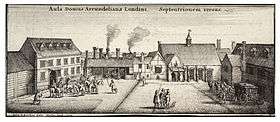Arundel House
Coordinates: 51°30′43″N 0°6′51″W / 51.51194°N 0.11417°W


Arundel House was a London town-house or palace located between the Strand and the River Thames, near St Clement Danes. It was originally the town house of the Bishops of Bath and Wells, during the Middle Ages. In 1539 it was given to William Fitzwilliam, Earl of Southampton.
It reverted to the Crown on Fitzwilliam's death and was granted in 1545 to Thomas Seymour, brother to Edward Seymour, 1st Duke of Somerset, Protector (of the infant King Edward VI, son of King Henry VIII). After Seymour's execution in 1549 for treason, the house was sold to Henry Fitz Alan, 19th Earl of Arundel, for around £40.
It later housed Thomas Howard's collection of Old Masters and classical sculpture, the "Arundel marbles", most of which are now in the Ashmolean Museum, though a 2nd-century AD relief from Ephesus kept at the house may be seen in the 17th century gallery at the Museum of London). Arundel House also hosted his protégé Wenceslaus Hollar.
An entrance gateway designed by the court architect, Inigo Jones, has been demolished along with the rest of 17th-century Arundel House, commemorated in Arundel Street. The present late 19th-century Tudor Revival Arundel House, at the foot of Arundel Street on the corner of Temple Place, is a conference centre that currently serves as the headquarters for the International Institute for Strategic Studies.
The Roman Baths, Strand Lane were situated within the grounds, and remain in the ownership of the National Trust.
References
| Wikimedia Commons has media related to Arundel House. |
- Walford, Edward. Old London: Strand to Soho. London: The Alderman Press, 1987. Orig. publ. 1878. ISBN 0-946619-31-X
- Weinreb, Ben, and Christopher Hibbert, eds. The London Encyclopædia. 2nd edition (1st ed. 1983). London: Macmillan, 1992. ISBN 0-333-57688-8
External links
- Arundel House article from The Map of Early Modern London project at The University of Victoria
- Hollar's etchings of Arundel House from the North and South, plus the 1647 view of the City from the top of Arundel House
- Account of Arundel House, with plan of Arundel and Essex Houses